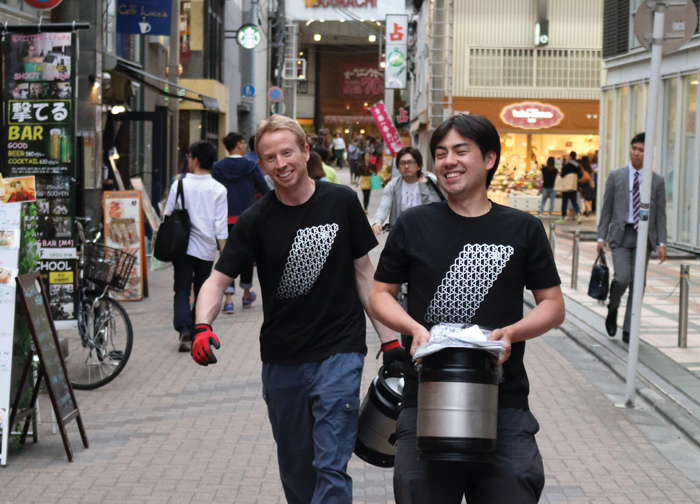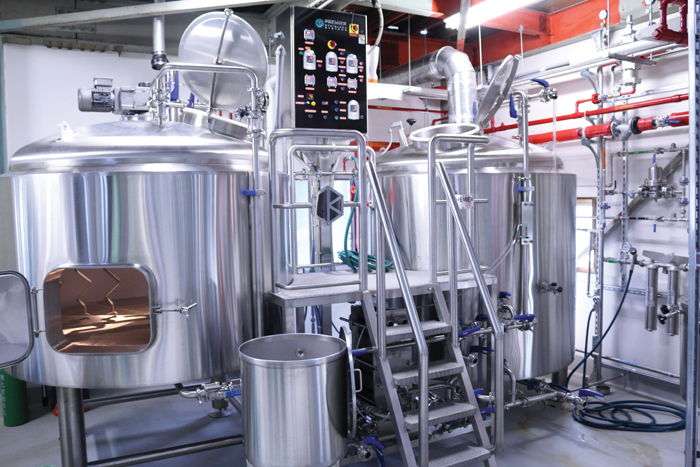What makes something authentically Kyoto? It’s a question scholars could spend a career trying to answer. Most Kyoto families in traditional businesses have been pursuing authenticity in their work for generations. What makes the grade in Kyoto usually requires the acknowledgement of powerful groups and individuals, from established businesses to influential monks. Being ‘true to Kyoto’ is very different from being ‘true Kyoto.’ The latter is earned by great sacrifice and devotion to the former. Being true to Kyoto, at a very minimum, means respect for local traditions, hierarchies and ways of doing business.
There are many ways to experience true Kyoto: participation in a local tea ceremony, dining at certain restaurants, studying one of the ancient arts under a local master or even just attending one of the many neighborhood festivals. It could also mean taking a sip of beer from the recently opened Kyoto Brewing Company. So far, they seem to be taking the proper steps for local recognition and that certainly starts with making a quality product people can be proud of.
There’s plenty of kitsch in Kyoto. Being one of the world’s most popular tourist destinations can make the widespread availability of cheap souvenirs inevitable. You can even find T-shirts printed with the word “ninja” at shops on the doorstep of Kiyomizudera. The food and beverage industry, however, tends to be more discerning. Naturally, proprietors of fine restaurants, bars and retail liquor shops might be wary of some non-Japanese that moved to Kyoto and established a brewery with the Kyoto name. Are they just here to profit from the cachet that the Kyoto name carries? How will they gain acceptance?
Co-founder and brewmaster Chris Hainge answers, “I think we’ve tried to be honest and that’s the first thing. I’ve been living in Kyoto for seven years and when I first got here I knew this was the final place in Japan I wanted to live. I’ve lived five or six other places. Once we got the idea of doing the business, we realized Kyoto really was the best place for it because Kyoto has such a tradition of craftsmanship. That has so many parallels with making beer. We’ve been helped by many in Kyoto who see a lot of potential in what we’re doing. They are excited about seeing somebody who isn’t from Kyoto but is willing to come here and start a new business that will hopefully represent the city. That’s why we chose the name we did. We want to make beers that represent everything that Kyoto stands for. That’s a tall order, but I think we can do it.”
The “we” in Kyoto Brewing Company includes co-founders Paul Speed and Ben Falck. All were colleagues over a decade ago in Aomori, where they were teachers on the Japan Exchange and Teaching Program. They’ve been friends ever since. Like many craft breweries, it was home brewing passion, in addition to pre-existing friendships, that provided a foundation for the business.
Hainge relates, “Once I started home brewing in college I realized how intricate and interesting it is. The more I did it, the more my hobby started to take over my life. At one time, two thirds of my apartment was home-brewing equipment. I used to go snowboarding every weekend but then I found myself brewing three out of four weekends instead. Something had changed in my passion for making beer. It was taking precedence over pretty much everything else so I told myself I needed to make this my job.”
Speed, meanwhile, was taking an MBA course at McGill University in Japan called “Entrepreneurial Enterprise.” He explains, “It was basically about how to start a company. During that time, Chris came over to my house for the weekend and told me he wanted to start a brewery. I wanted to start a business and that’s how it started.”
Speed had tried some of Hainge’s homebrew several years earlier and describes being blown away by its quality. He matched Hainge’s apparent talent for brewing, though, with his budding business acumen.
Describing his time at McGill, Speed notes, “In order to graduate from the MBA program, you have to write a kind of thesis or put together a business plan. I decided to do the business plan; it was a win-win situation. I prepared a ninety-page document, though the one that eventually went out to investors was about sixty pages. I had done my homework and all the calculations—it was a pretty good business plan, I guess. We raised a million dollars.”
Together with Falck, they approached friends, family and former co-workers for the funds. With some individuals, they had to cool expectations for astronomical returns, and for all, they asked for patience and a long-term commitment.
Prior to much of this fundraising activity, Hainge began honing his brewing skills with professional training. For two years, he participated in a distance-learning program through the American Brewers Guild, which culminated with an apprenticeship at The Lost Abbey brewery in San Diego. That followed with a seven-month stint working at Shiga Kogen Beer in Nagano. According to Hainge, those two experiences taught him about the whole brewing process, from inventory management to packaging. Just before launching Kyoto Brewing Company, he spent three months at Ushitora as they got their brewery off the ground with help from Luc LaFontaine, the former brewer of Dieu du Ciel (Montreal). Hainge further mentions Oshita Kaori, of Minoh Beer, as having been very generous with her time and advice. LaFontaine was additionally brought on in a consulting role for Kyoto Brewing Company’s first few batches. In defining the company’s overall brewing philosophy, Hainge borrowed a little from Shiga Kogen’s mantra (common among many craft breweries), “We brew the beers we want to drink.” For him, that meant Belgian-American styles in general.
When asked to elaborate, Hainge explains, “The way I like to think of it is taking Belgian and American traditions and combining the best parts of both. Especially in Japan, I think a lot of breweries try to get the yeast to have the least amount of flavor possible in the beer. With Belgian beer, that’s almost the whole point; the flavor of the yeast drives the flavor of the beer. It seems kind of wasteful to not have that flavor in your beer when you think about how much flavor it can provide. I thought it would be good to take the flavor of the Belgian yeast and then take the flavors from American hops—impactful, very aromatic, citrusy—and combine the two together. So in my mind it is taking what we respect from both brewing traditions and piecing them together in interesting ways.”
Even extremely successful craft breweries that typically brew the beer they like to drink will follow market trends and brew a range of styles to increase profits. If something in KBC’s lineup doesn’t sell well, or if something in the Japanese market is becoming popular, will they consider altering their approach?
“Definitely yes,” says Hainge. “As we were getting started we went around to a lot of bars and asked them what was selling and what wasn’t. Just as an example, people say wheat beers are very popular. For me personally, the traditional German hefeweizen is OK, but it’s not my favorite style in the world. We took that advice and thought about how we could take a wheat beer and put an interesting spin on it that would make it closer to a beer that we’re interested in, whether that means adding a little more hops or making it a little more sour. If we can play with an idea like that, we can get closer to what customers want, but also stay true to what we want to drink.”
The first beers Hainge brewed included a hoppy pale ale, a Belgian blonde and an American blonde hybrid. The collaboration beer he brewed with LaFontaine was a “secret” (that actually became the name of the beer), but tasted like some kind of saison-hybrid. Following these initial beers, which all sold out quickly, Hainge began producing two that he anticipates will be closer to their year-round beers: a saison and a Belgian IPA, both of which were tributes to The Lost Abbey and Shiga Kogen.
When asked about whether he would adopt anything from the Japanese brewing tradition, Hainge answers, “I think Japan is still trying to find its craft beer identity. America has found it with high impact, flavorful, high-IBU beers. But just knowing the Japanese palate in the context of food, I think most brewers are going for a more subtle approach where everything is well-balanced and not too extreme in any way.” Indeed, Hainge’s beers seem similarly well-balanced. Despite his proclivity for hop-forward beers with strong Belgian character, they seem as if they would go very well with Japanese cuisine.
The equipment in Kyoto Brewing Company includes a 15-barrel brewhouse (1.78 kiloliters) with a simple mash-lauter tun and kettle-whirlpool. When they started, they were estimating that in their first year they would make between 50 and 60 kiloliters of beer, with that rising to 100 kiloliters when all four fermentation tanks were in use. Those plans, however, quickly went out the window with the runaway success of their launch.
Speed happily complains, “We were forecasting having to double our capacity with new tanks in about two years. That necessity came in just two months.”
Even if they continue adding tanks to catch-up to demand, their current facility can only accommodate about 400 kiloliters of total capacity. Strained capacity, perhaps, is a good problem to have, but their successful launch was not without some serious challenges.
The U.S. West Coast port strike (that has since been resolved) delayed the shipment of their brewery equipment by at least a couple months. During that period, they were bleeding money on rent.
Speed reflects, “There was nothing we could do about that except scramble to find more money. If you are out there and thinking of starting a brewery, definitely try to get much more money than you think you need and always be prepared for the unexpected. Double the budget!”
It might be wise to have some experienced help at hand, too. On the very first day they cranked up the machinery, all kinds of things started going wrong.
Hainge explains, “The boiler went out four times during the boil. Thankfully, the engineer from Premier was here, as well as Luc, to help us make adjustments. We also discovered halfway through brewing that we weren’t able to steam sanitize our oxygen line so we had to find a workaround for that. It was basically just trying to keep the doors from falling off for eight hours!”
It seems that things are humming now and that they are very pleased with their equipment, the design of the brewery (care of Hori Teruya of Laff International) and the quality of the beers they are producing.
All that lies ahead now is the future and its many possibilities. No doubt they will be working ever more closely with the Kyoto community.
As Hainge notes, “We’re making a lot of contacts within the craftsman community in Kyoto. We’re finding a lot of parallels with what we’re doing and learning a lot from them. Even though they are making a different product, they are facing a lot of the same struggles.”
Those artisans–potters and textile producers–believe in what they are making, even if they are not able to sell them right away. Hainge, Speed and Falck are far beyond those concerns. Perhaps it’s time to have a deeper conversation with those artisans about what makes them respected in Kyoto. Perhaps the trio will find they are already halfway there.
This article was published in Japan Beer Times # () and is among the limited content available online. Order your copy through our online shop or download the digital version from the iTunes store to access the full contents of this issue.







